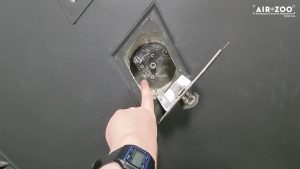Reviews
User Score
Rate This
Descriptions:
A team of engineers in Toronto, Canada are awaiting official confirmation that they have broken an aviation record for the first ever sustained flight in a human-powered ornithopter, an aircraft that flaps its wings like a bird. The team managed to keep the aircraft aloft for almost 20 seconds, a feat that breaks new ground in avionics and flapping-wing technology.
Just as the sun was rising on August 2, 2010, so was “Snowbird.”
The flight was the culmination of three years work and while it lasted just 19.3 seconds over a distance of 145 meters it was enough to propel “Snowbird” and her creators into the record books.
“Snowbird” is an ornithopter, designed to fly by flapping its wings.
Todd Reichert, the project leader and pilot, flew the Snowbird on its record flight.
[Todd Reichert, Project Leader]:
“We wanted to accomplish kind of the original aeronautical dream which was to fly under your own power by flapping your wings.”
For centuries engineers have attempted to design a viable human powered aircraft. Leonardo da Vinci sketched an ornithopter in 1485.
Snowbird may appear low-tech, but she’s the product of sophisticated computer simulation programs the engineers needed to defy their biggest nemesis; gravity.
Snowbird’s wingspan is comparable to that of a Boeing 737 but, according to Reichert, weighs less than all the Boeing’s pillows.
And to keep the overall weight of the aircraft as low as possible, Reichert put himself on a diet before the record-attempt.
[Todd Reichert, Project Leader]:
“If you have a big wing and it is moving forward than your plane is going to be lifted up. What the flapping does is actually provide thrust. So each time you push down, you are blasting air backwards and that helps push you forward.”
Using his legs as pistons to keep the wings flapping via pedals and a pulley system, Reichert’s effort alone keeps Snowbird aloft…for a while.
Chief Structural Engineer Cameron Robertson says human-powered flight will never become an efficient means of transporting people, but that their achievement will lay the groundwork for future developments in wing flapping technology.
[Cameron Robertson, Chief Structural Engineer]:
“The design program is for flapping wing flight in general and flapping wing flight is something that is also becoming very popular because as you go small flapping wings make sense. And that is the direction that a lot of unmanned aircraft are going – is very small,” he said.
Tiny aircraft for search and rescue or spying missions are what the team has in mind.
The pair was told along the way that Snowbird would never work.
Reichert says the greatest lesson learned has been that despite the sceptics, with persistence any good idea can take flight.







